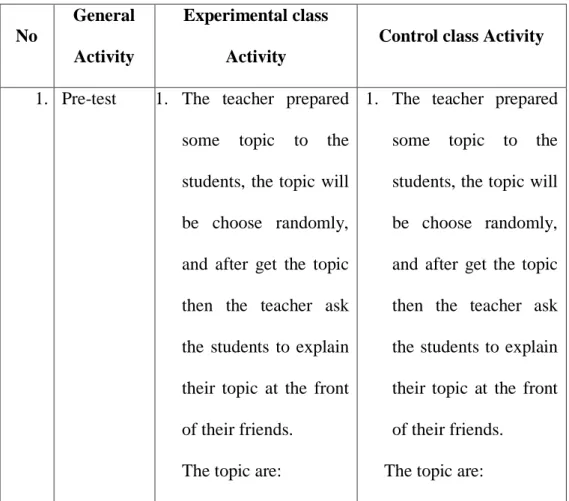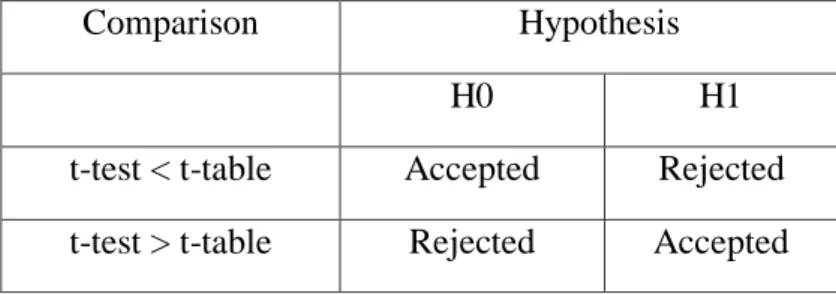The above result showed that there was a significant improvement in the students' speaking skill through discussion (CLT) at SMKT SombaOpu (Gowa). According to Littlewood in Leong (2017) it is expressed that the language classroom can also cause inhibitions and fear in students. The second is the lack of content knowledge, sometimes when the teacher asks the students to speak, they cannot say anything.
The first factor lies in the personality of the students. According to Chong in (Abdullah, et al., 2012), the trait of self-efficacy, showing more curiosity and exploration, would motivate students to become more active and positive reciprocating. The last problem is the use of the native language. The use of the mother tongue has such an influence on the speaking skills of the pupils. The students always use their mother tongue if they can't say anything in a foreign language.
In order to improve students' speaking skills, the researcher must of course solve all the above problems by applying the right approach to learning. Communicative language teaching is the approach that the researcher believes can solve students' speaking problems and improve students' speaking skills.
Problem statement
To prove this claim, the author conducts a study on “The Effect of Communicative Language Teaching on Improving Students' Fluency”.
Objective of the Research
Significance of the Research
The result of the research can become a reference and provide informative input to solve a similar problem.
Scope of the Research
REVIEW AND RELATED LITERATURE
- Previous of related literature
- Speaking skill
- Definition of speaking
- The Purpose of Speaking
- Aspects of Speaking Skill
- The Principles of Teaching Speaking
- The Roles of The Teacher in Teaching Speaking
- Problems in Teaching and Learning Speaking
- Principle in Designing Speaking Technique
- Assessing Speaking
- Communicative Language Teaching
- Definition of Communicative Language Teaching
- The Important of Communicative Language Teaching
- The Competence of Communicative Teaching Learning
- Communicative Teaching Learning Activities
- Types of Communicative Activities
- Steps in conducting Discussion activity
- Conceptual Framework
- ConceptualFramework
The research on speaking was done by Nasidah Lubis and read: “The effect of the sociodrama method on learning to speak”. This research was conducted to find out how to improve students' speaking skills during English lessons by using an action-learning strategy. The result of the research is: In the first test (pre-test), the students who passed the KKM 75 were 4 students out of 48 students (9.09%).
It concluded that the result of the research showed that the implementation of action learning strategy can improve the students. All the research above is the implementation of communicative language teaching, the same as in this research. The successes of the learning process depend on the teachers who understand their role in the teaching and learning process, especially in the teaching of speaking.
Feedback is primarily from the teacher, but can be found outside the classroom. The CLT approach is one of the communication methods where the learning process focuses on students and the teacher as a facilitator.
Teaching
Hypothesis
Research Design
- Population
- Sample
The researcher chooses two classes as a sample, the total sample consists of 41 students. They are XI-TKR 2 as the experimental class and XI-TKJ1 as the control class. The sample in the experimental class consists of 20 students and the control class consists of 21 students.
Variable of the research
Instrument of Collecting Data
Procedure of Collecting Data
Discussion was the teaching and learning technique that focuses on group work, and then Talking stick was the teaching and learning technique that focuses on individual work. The teacher prepared some topic for the students, the topic will be chosen randomly and after getting the topic, the teacher asks the students to explain their topic in front of their friends. Before the lesson starts, the teacher asks the students to arrange a bench in the shape of
After choosing a topic, each group will discuss the topic, in this case the researcher will accompany the students. A group member could be assisted by a leader if the group member is unable to respond to a question or criticism or comment from another group. After everyone in the group has presented their work, the researcher will take over the lesson and give the students some evaluations to remember the material and the topic.
And when students explain their thoughts about their topic, the teacher gives an assessment of the student's explanation.

Technique of Collecting Data
Technique of Analysis Data
Based on the above data, the researcher concluded that the students' ability to speak English was still low. After receiving data from pre-test and post-test, the researcher calculated the percentage of students' improvement and the result showed that students' improvement in vocabulary categories was 36.42%. Then the researcher calculated the percentage of the students' improvement and the result showed that the students' improvement in pronunciation categories was 43.77%.
Then the researcher calculated the percentage of students' improvement and the result showed that the students' improvement in accuracy categories was 36.94%. The table above showed that the average accuracy score of the students in the experimental class before the tests was 13.7 and the average score of the students after the test was 18.7. Then the researcher calculated the percentage of students' improvement and the result showed that the students' improvement in the fluency categories was 36.5%.
Based on the data of the four categories, the data showed that the speaking ability of the students in the experimental class had improved. So the researcher concluded that the use of communicative language teaching in the experimental classroom was effective to improve students' speaking skills. It was shown that the treatment implemented by the researcher was effective to improve students' speaking skills.
Then the researcher calculated the percentage of improvement of the students, and the result showed that the improvement of the students in the vocabulary categories was 21.62%. Then the researcher calculated the percentage of improvement of the students, and the result showed that the improvement of the students in the pronunciation categories was 30.14%. Then the researcher calculated the percentage of improvement of the students, and the result showed that the improvement of the students in the accuracy categories was 15.50%.
Then the researcher calculated the percentage of students' improvements, and the result showed that the students' improvement in Fluency categories was 23.14%. Based on the data of the four categories, the data showed that the students' speaking skills improved in experimental class. The results of the study showed that the use of group discussion was effective in improving the students' speaking skills.

Conclusion
Suggestions
An experimental research design to determine whether the use of communicative language teaching affects the improvement of students' ability in other skills such as writing, reading and listening. Then, future researchers can also conduct a study on the application of the communicative language teaching approach to writing other genres to see the effect on its use. Abbaspour, Faezeh. 2016. Speaking competence and its components: A review of the literature. International Journal of Linguistics, Language Teaching and Assessment Research. Vol.
2017. Improving students' speaking skills in English class with Action Learning strategy in grade eight MtsPab 1 Helvetia. Does the native language influence the learning of a second language?.Journal Foreign Language Education and Technology.Volume 2.No. Communicative language teaching and its impact on student achievement.Journal of Education and Social Research.Volume 5.No.1.
Improving English speaking skills: the role of six factors. Advances in language and literature studies. Volume: 8 Edition: 6. Improving the speaking skills of students through communicative language games at SMPN 1 Prambanan Grade VIII A in the academic year of.
APPENDICES
Mean score of the Pre-test and Post-test
Student scores of pretest Y1 and posttest Y2 , Gain/Difference between matched pairs (D) and gain squared D2 of the Experimental class.

Appendix G
The validity of the research Intrument